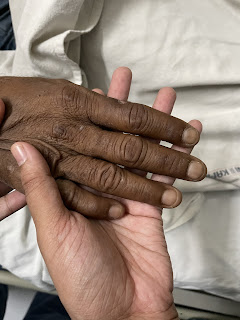45 year old male with giddiness
This is an a online e log book to discuss our patient de-identified health data shared after taking his / her / guardians signed informed consent. Here we discuss our individual patients problems through series of inputs from available global online community of experts with an aim to solve those patients clinical problem with collective current best evident based input.
This E blog also reflects my patient centered online learning portfolio and your valuable inputs on the comment box is welcome.
I have been given this case to solve in an attempt to understand the topic of " patient clinical data analysis" to develop my competency in reading and comprehending clinical data including history, clinical findings, investigations and come up with diagnosis and treatment plan.
45 year old male patient who was a driver by occupation came to the casualty with chief complaints of
Giddiness since yesterday afternoon
Vomitings since yesterday afternoon
Shivering since yesterday afternoon
HOPI:
Patient was apparently asymptomatic till yesterday afternoon and then developed giddiness since yesterday afternoon, insidious in onset, not progressive ,increased on getting up from bed,so he called his wife and informed.His wife has sent his son home.By the time the son saw the patient,patient was shivering,so his son gave him some buttermilk,after which the patient has vomited the buttermilk associated with difficulty in walking
3 episodes of vomitings,non bilious,non projectile,food as content,non foul smelling,non blood tinged
No complaints of abdominal pain,loose stools
No complaints of tinnitus,limb weakness,seizures,loss of consciousness, tingling and numbness of limbs,blurred vision,change in voice,hearing loss or fever
No complaints of head injury,chest pain ,palpitations,Shortness of breath,syncopal attacks,pedal oedema
PAST MEDICAL HISTORY:
4months patient came to our hospital with complaints of shortness of breath and was diagnosed with pneumonia and alcoholic liver disease.After admission he had one episode of alcohol withdrawal seizure
He was counselled for getting admitted into DAC ,but Patient was not willing.
No other previous admissions in hospitals
Not a k/C/o DM ,HTN,CVA,Epilepsy,CAD
PERSONAL HISTORY:
Mixed diet
Appetite reduced
Regular bowel and bladder habits
Smoker since 18 years (daily one pack of cigarettes)
Alcoholic since 18 years
He is the youngest child in his family
Studied upto intermidiate
Started working in pharmacy,after working for 3-4 years ,he got married-1st degree consanguineous marriage
His mother expired because of CVA(hypertensive ,drug defaulter) around 20years ago
His father expired due to renal failure 20years ago
Patient has 2 sons
After marriage he stopped working in pharmacy and brought and auto for himself.He started drinking alcohol and smoking along with other auto drivers.
After few years he sold his auto and with that money bought a car ,which he used to give for rent
And started working as driver and used to transport hens for chicken shops-night driver
Starts at 7pm at home and comes back home at 9am after drinking alcohol
After getting admitted 4 months back he stopped going to work and his family was dependent on car rent for their income
His elder sons friends had taken their car for rent one day, they met with an accident and did not pay for car repair
Upon that they made his elder son pay for the medical expenses of one of his injured friend which they have promised to repay but they did not.
So his elder son has committed suicide by taking ?pesisticide and got admitted in EMD department and later got discharged.
Due to all these financial issues and family problems he started drinking more alcohol and decreased eating food.
FAMILY HISTORY:
Mother is hypertensive,expired due to CVA after she became bedridden for 6months
Father expired because of renal failure
DRUG HISTORY:4months back used tab benfothiamine and tapering dose of lorazepam for 10days and later discontinued and did not come for follow up
ON EXAMINATION:
Patient is drowsy but arousable on day 2 of admission
On day 3 patient is conscious and coherent
Oriented to time place person
Moderately built and nourished
No pallor,icterus,cyanosis,clubbing,lymphadenopathy,pedal oedema
VITALS :
PR:86bpm,regular rhythm,normal volume and character
BP:130/80mmhg
RR:18cpm
Temp:97.6F
Spo2:98% on RA
Grbs 105mg/dl
Jvp:Normal
No alopecia,Gynecomastia,spider angioma,palmar erythema
SYSTEMIC EXAMINATION:
CNS:
•HIGHER MENTAL FUNCTIONS:
Patient is conscious ,coherent and cooperative
Oriented to time ,place,person
GCS-15/15
SPEECH:
Fleuncy,comprehension,Repetition intact
MEMORY
Recent,Remote,Immediate: intact
No delusions,hallucinations
•CRANIAL NERVE EXAMINATION:
I-
2- visual acuity 6/6CF in both eyes
Field of vision Normal
3,4,6:
EOM: normal in both eyes
Direct LR:+
Indirect LR:+
Accomodation:+
Ptosis:absent
Nystagmus:+
5:Sensations over face intact
Muscles of mastication intact
Corneal and conjunctival reflexes+
Jaw jerk-
7:No deviation of mouth,frowning normal
Moisture of eye and tongue normal
8: Rinnes Air conduction>bone conduction
Webers:No lateralisation
Nystagmus +,both vertical and horizontal,fast beating component towards right side in both eyes
9,10:No deviation of uvula
palatal movements normal
11:shrugging of shoulders normal
12:Movements of the tongue normal
No wasting of tongue,fasiculations
•MOTOR:
Bulk of muscle normal on both sides on inspection
Tone normal in all 4 limbs
Power 5/5 in all 4 limbs
Hand grip 100% on both sides
Reflexes R L
Biceps: 2+ 2+
Triceps 2+ 2+
Supinator 2+ 2+
Knee 2+ 2+
Ankle - -
Plantar Flex Flex
GAIT:Wide based gait with swaying to both sides and back
SENSORY:
Not able to elicit properly as patient was drowsy and not willing to answer and is confused(took tab lorazepam on day 2 of admission)
On day 3 of admission:
1.Spinothalamic: R L
Crude touch + +
Pain + +
2.Posterior column:
Fine touch + +
Vibration Reduced
ankle 5 sec 4.8sec
Knee. 7sec. 6.6sec
Wrist. 7sec. 6.9sec
3.Cortical
Stereognosis: + +
CEREBELLUM:
Nystagmus+
Both vertical and horizontal ,in both eyes with fast beating to right side
Tremors+
Finger finger test -past pointing+ on day 2 of admission
On day 3 of admission: Finger nose and finger finger test were normal
No dyadiadokokinesia
No pendular knee jerk
Heel knee test on day 3 of admission: normal
Rombergs: swaying to right and back even with eyes open
•MENINGES:
No neck stiffness
Kernigs negative
Brudzinski negative
•SPINE AND CRANIUM -normal
•CAROTIDS:No bruit
CVS:
Apex 5th ICS 1cm medial to mid clavicular line
No parasternal thrills or heave
S1S2+
No murmurs
RS:
Inspection:chest elliptical bilaterally symmetrical
No tracheal deviation
Movements appear normal
Palpation: Inspectory findings confirmed
Percussion:Resonant note heard over all areas
Auscultation: normal vesicular breath sounds in all areas bilaterally
PA:
INSPECTION:
Shape :normal ,inverted umbilicus
No visible veins,scars
PALPATION:
Soft,non tender
No Organomegaly
PERCUSSION:
Liver span :13cms
AUSCULTATION:bowel sounds heard.
DIAGNOSIS:
?Wernickes encephalopathy secondary to thiamine deficiency (Alcoholism)
?PCA stroke
?Dry beri beri
Investigations:
Ecg:
USG abdomen
Wernicke encephalopathy (WE) is an acute neurological condition characterized by a clinical triad of ophthalmoparesis with nystagmus, ataxia, and confusion. This is a life-threatening illness caused by thiamine deficiency, which primarily affects the peripheral and central nervous systems
Korsakoff syndrome is a neuropsychiatric disorder associated with memory disturbances in which there are significant deficits in anterograde and retrograde memory. Immediate memory is maintained, but short-term memory is diminished with intact sensorium. The disorder is associated with patients fabricating stories in the setting of clear consciousness. Confabulations can be spontaneous or provoked with provoked confabulation commonly seen in chronic Korsakoff syndrome and spontaneous confabulation usually noted in the acute Wernicke state
How can thiamine deficiency cause Wernickes encephalopathy?
Vitamin B1, is a coenzyme that is essential for intricate organic pathways and plays a central role in cerebral metabolism. This vitamin acts as a cofactor for several enzymes in the Krebs cycle and the pentose phosphate pathway, including alpha-keto-glutamic acid oxidation and pyruvate decarboxylation. Thiamine-dependent enzymes function as a connection between glycolytic and citric acid cycles. Therefore, deficiency of thiamine will lead to decreased levels of alpha-keto-glutarate, acetate, citrate, acetylcholine and accumulation of lactate and pyruvate. This deficiency can cause metabolic imbalances leading to neurologic complications including neuronal cell death. Neuronal death in the mammillary bodies and thalamus were implicated in multiple cases of Wernicke encephalopathy studied.
Patient review on day 3 of admission:
S:Patient feeling subjectively better
No giddiness
Difficulty in walking still +
O:Tremors+
Ataxic gait +
Nystagmus+
A:As patient is responding to iv thiamine
It is more likely to be Wernickes encephalopathy
P:I.V thiamine supplementation
Daily psychiatry review.
Neuro-ophthalmic manifestations of WE involve both the efferent and afferent visual systems. There is a spectrum of ocular motor abnormalities that occurs in patients with WE. Nystagmus is the most common ophthalmic sign and is typically horizontal gaze-evoked nystagmus (GEN).7,8 Of note, GEN is thought to be the earliest indication of thiamine deficiency.9 Horizontal GEN often evolves in stages in patients with WE. Initially, it manifests as brief, nonsustained nystagmus. Next is sustained nystagmus without deficits in gaze-holding. Finally, the nystagmus is accompanied with gaze-holding failure, indicating involvement of the nucleus prepositus hypoglossi (horizontal gaze neural integrator).
Bilateral abducens palsy is the next most common ophthalmic finding, followed by conjugate gaze palsies, more frequently horizontal than vertical.17,18 Unilateral internuclear ophthalmoplegia has been rarely reported,19 but bilateral is especially rare, and only one case could be found.20 One might expect complete ophthalmoplegia to be common in WE since it is often mentioned as part of the classic triad. Yet this is an infrequent occurrence in WE.18,21,22 The evolution of ocular motility disturbances from the various stages of nystagmus to ophthalmoparesis and ultimately, in advanced disease, complete ophthalmoplegia, has been well documented clinically and supported in an animal model.










Comments
Post a Comment